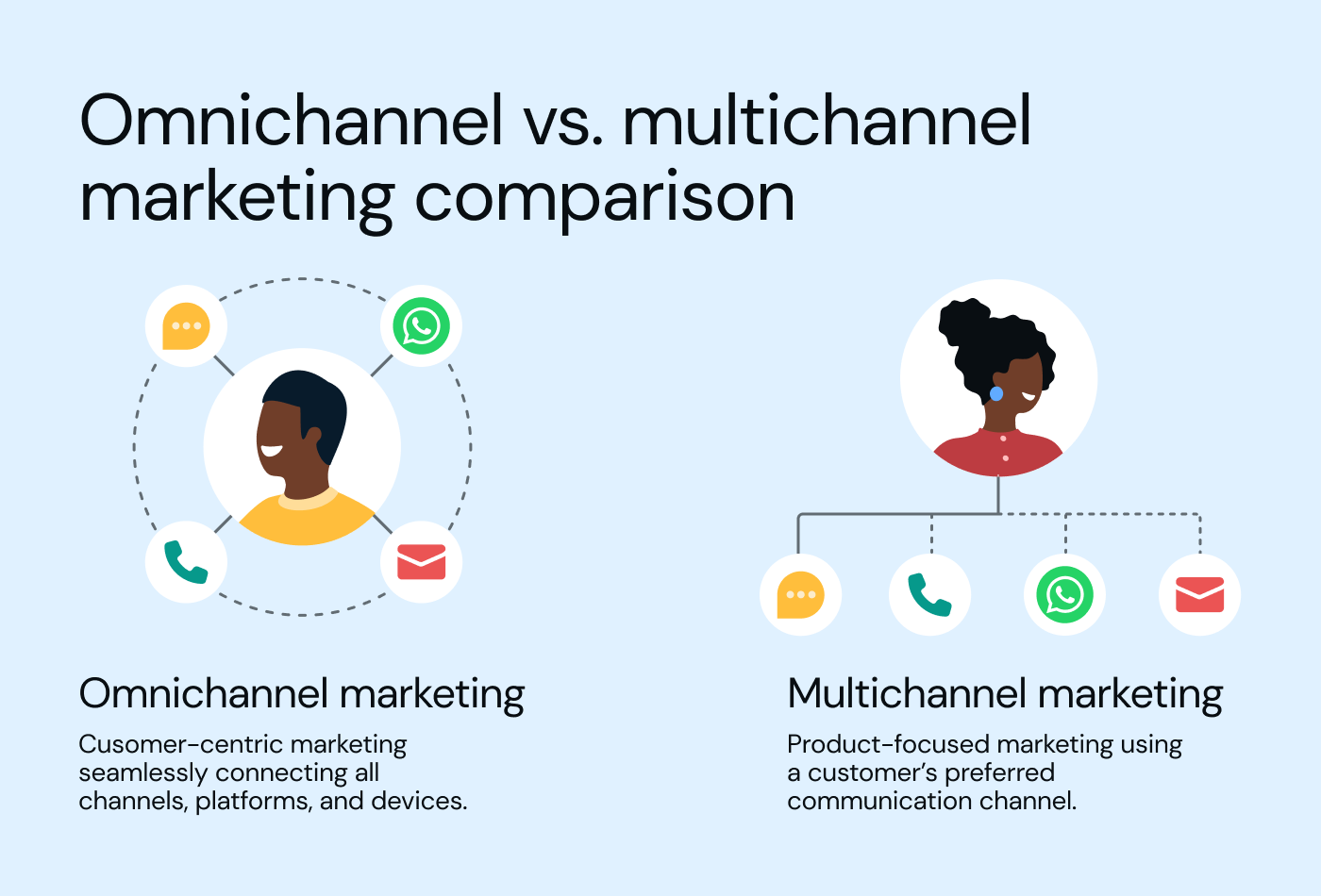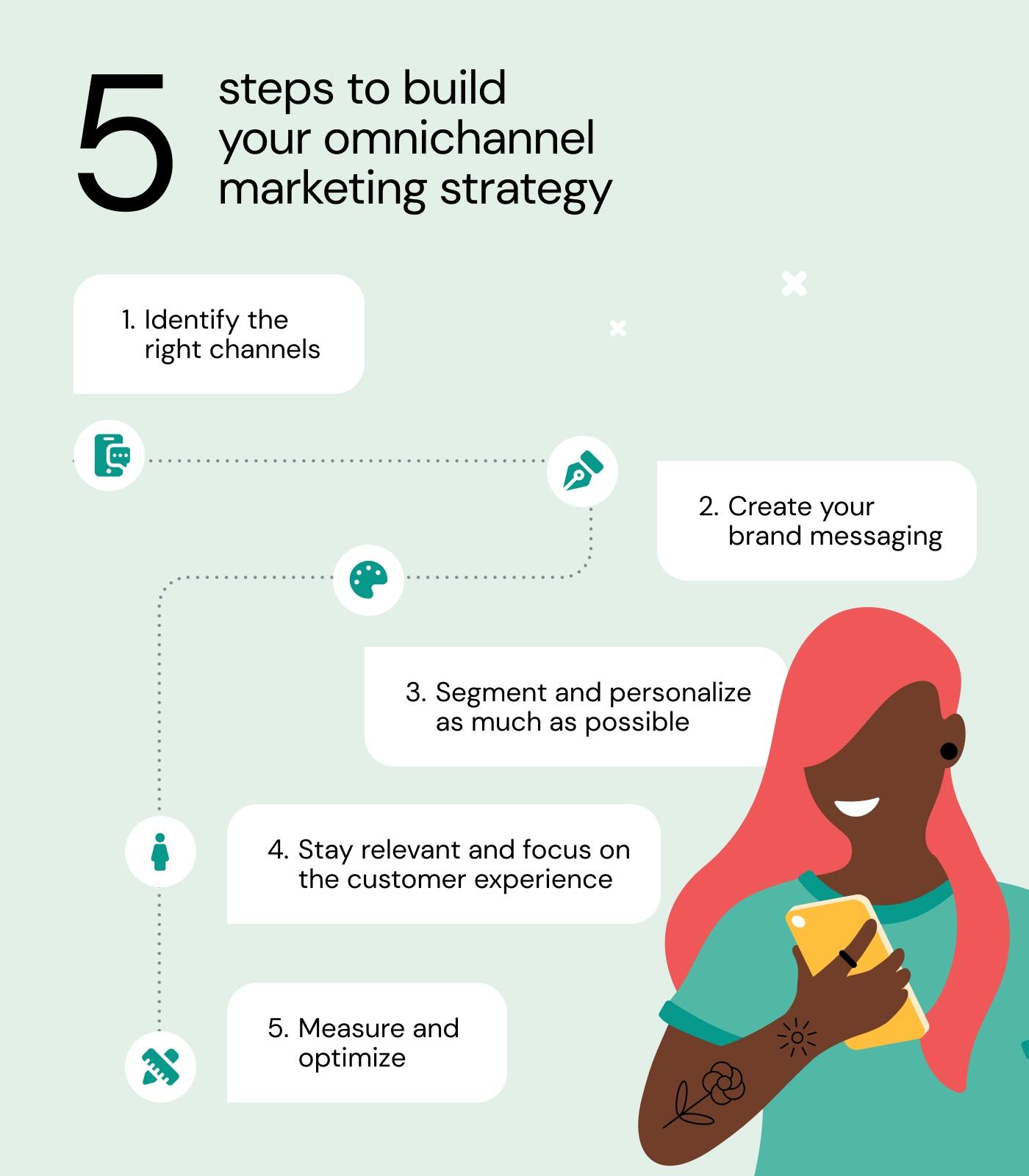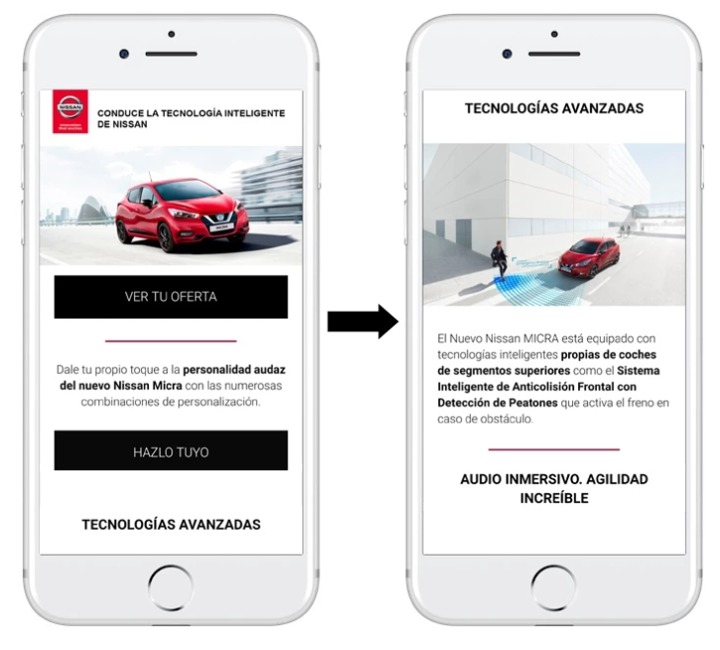Insights
What is omnichannel marketing? A complete guide to offer great customer experiences

Insights

Customers expect a consistent experience across all channels when interacting with a brand. In fact, 26% of consumers are deterred by brands that send communications too frequently, while 25% are put off by irrelevant messages. Unfortunately, many marketing teams struggle to deliver this consistency.
Getting the right balance in messaging frequency and relevance is crucial for meeting customer expectations. And inconsistent experiences lead to confused, frustrated customers. They may even turn to competitors who better meet their needs.
Omnichannel marketing campaigns solve this problem. This strategy means using channels like web, social, email, and more in a coordinated, unified way.
In this article, we’ll cover what omnichannel marketing is and how you can create a campaign that gives customers a seamless experience, no matter where they interact with your brand.
Omnichannel marketing means using various channels and platforms to promote your business consistently. It’s about being everywhere your customers are, in a way that feels natural and connected.
Customers turn to an average of nine different channels to communicate with companies. Omnichannel marketing makes it easy and convenient for customers to engage with a brand, no matter which channel they prefer. This way, they get a seamless experience with consistent messaging.
These are just a few channels you can use for omnichannel marketing:
The key to an omnichannel customer journey is that multiple channels are used together in a coordinated way. This creates a cohesive brand experience that puts the customer first and will help you build stronger relationships to generate more sales.
Despite the fact that omnichannel and multichannel marketing involve engaging customers across multiple platforms, they’re not quite the same. The difference lies in how they manage customer interactions when you move between channels.
Suppose you’re planning a vacation, and you start by researching hotels on an online travel agency’s website.
If the travel agency has an omnichannel approach, you might get personalized email recommendations based on your search. When ready to book, you do it with a few clicks, because the website has access to all your relevant info.
On the flipside, a multichannel approach might feel more disjointed. Even though you can interact with different hotels through various channels, your browsing history and preferences may not carry over. And you may need to provide your information again when booking through a different channel.
To sum it up: Omnichannel marketing involves truly understanding the customer and using that insight to enhance their experience across all channels in a seamless, interconnected way.
On the other hand, multichannel marketing provides multiple ways for customers to engage with a brand, offering choice and convenience. However, the experience may not be as smooth or personalized when moving between different touchpoints.

These days, customers expect a lot from brands. They want personalized experiences and consistency across all interactions.
An omnichannel approach is perfectly in line with what modern consumers are looking for. And this approach is especially important for omnichannel ecommerce, where customers might research products online, visit physical stores for a closer look, and then make their purchase through a mobile app or website.
Here are seven benefits of an omnichannel marketing strategy:
Building a strong omnichannel marketing strategy takes planning. Here’s a straightforward five-step process to get you started on creating a cohesive customer experience across all your channels.
Building a strong omnichannel marketing strategy hinges on understanding your target audience. Instead of getting overwhelmed managing a dozen different platforms, pinpoint where your ideal customers spend their time.
Similarly, building a brand presence demands targeting channels where your audience is already digging for information and entertainment. Three ways to unearth these valuable channels include:
These strategies create a detailed omnichannel marketing approach that reaches customers across platforms. You reach your ideal customers on their preferred turf and don’t waste resources on irrelevant channels.
Brand messaging is the core message your brand conveys to customers. All marketing channels should reflect your values, personality, and tone of voice.
A strong omnichannel strategy relies on a cohesive brand message. While you may vary the presentation based on context, the essence of your communications should remain consistent, regardless of where customers encounter your brand.
This includes channels like:
Each channel has its own strengths and limitations. For instance, a lengthy offer might not work well on an Instagram snippet, so you need to adapt the message format and length to suit each platform.
By mastering this balance, you can create a unified and recognizable brand presence.
Use what you know about each customer to tailor your messaging and offers to their specific preferences.
There are so many ways you could divide your customer base. You could segment your customers based on their:
Then, send targeted email campaigns with personalized product recommendations.
Imagine a customer who has previously bought several pairs of running shoes from your store.
You could send them an email featuring the latest running gear, along with a discount code for their next purchase. Or, if you know a customer’s birthday is coming up, you could send them a special birthday offer.
The more relevant and personalized your messaging is, the more likely customers are to engage with it.
By segmenting your audience and personalizing your communications with automation tools, you’ll build stronger relationships with your customers.
They’ll feel like you understand their needs and preferences. And that increases sales.
It’s not just about pushing your products or services. It’s about creating a positive experience that boosts customer retention.
One way to do this is by staying relevant. Keep an eye on industry trends and customer preferences. Adapt your messaging and offerings to solve their pain points.
Another key aspect is focusing on the customer experience. Every interaction a customer has with your brand should be positive and frictionless.
This is where tools like conversational AI can be a game-changer.
Imagine having a virtual assistant that can answer customer questions, provide personalized recommendations, and even handle transactions. Available 24/7 across multiple channels. Conversational AI provides instant, personalized support to your customers. It boosts satisfaction and loyalty in the process and reduces customer churn.
Many CX leaders plan to integrate generative AI into multiple customer touchpoints in the next couple of years. It’s likely to influence areas like chat-based customer support, email communications, search functionality, and voice-based interactions.
How can you be sure your omnichannel marketing strategy works?
You should be closely monitoring key performance indicators (KPIs) like:
These metrics not only show how well your omnichannel efforts click with your audience but also highlight critical gaps in channel integration, allowing you to refine and enhance your overall performance.
So how do you optimize your strategy?
Using these tools and focusing on data, you’ll develop an omnichannel strategy that adapts to your customers’ needs and helps you with long-term success and engagement.

Check out how real companies use omnichannel marketing to connect with customers across all platforms. Get ideas for your own campaigns that get results with these examples of omnichannel marketing.
BUT, a leading home furnishing store in France, had trouble getting visitors to its website and stores. The company also wanted to improve its customer experience across different channels and connect with customers in the ways they prefer.
To solve these problems, BUT worked with Sinch to create a plan that used WhatsApp. They started sending catalogs through WhatsApp every two months and made a chatbot to help people shop. People engaged with the catalogs and their website got more traffic.
To get even more people to use WhatsApp, BUT tested different ways to attract them. They found RCS messages worked the best, bringing in 46% of new WhatsApp users with a 20% click-through rate.
BUT increased its WhatsApp customers by 123% and had a 66% completion rate for chatbot conversations. They also sent RCS messages to over five million subscribers and now use RCS as part of their regular customer communication.
Amazon has become synonymous with a seamless omnichannel experience.
First, it prioritizes customer-centricity. It uses user behavior to personalize interactions across all channels. This means recommendations on the website might reflect your recent browsing history. Then, email recommendations include curated shopping lists accessible across devices.
This level of data-driven personalization creates a cohesive experience regardless of the starting point. It creates a convenient and interconnected online shopping experience that anticipates customer needs.
Nike weaves together online and in-person touchpoints for a seamless buyer’s journey.
First, the Nike app acts as a bridge. You can browse products online, check real-time stock availability at offline channels, and even reserve items for in-store pickup.
Physical store staff can also access your online order history and facilitate returns initiated online.
Plus, the Nike loyalty program also goes beyond channels.
It rewards points for both online and in-store purchases, offers personalized product recommendations in the rewards app, and unlocks exclusive member benefits across all touchpoints.
Whether you’re browsing online, visiting a store, or engaging with Nike on social media, the brand experience remains consistent.
Nissan, one of the world’s largest car manufacturers, faced two main challenges:
To overcome these issues, Nissan Europe collaborated with Sinch and Adobe Campaign to create a mobile-centric omnichannel strategy. They became the first automotive company in Europe to test Rich SMS messaging.
Using Sinch’s platform and Adobe Campaign, Nissan leveraged their CRM data to send personalized messages to customers such as:
Nissan also used the opt-in NissanConnect mobile app to reach drivers on the road.

The results of this omnichannel approach were significant:
After a successful trial, Nissan decided to expand its mobile marketing efforts, recognizing the value of this strategy in building long-lasting customer relationships and brand loyalty.
Customer behavior, tech, and competition change fast. Here are four current trends to keep your marketing strategy fresh.
By breaking silos and creating a seamless customer experience across all your channels, you build stronger relationships with your audience and see positive impacts on sales and ROI.
Want to learn more? Check out our omnichannel resource hub to help you build an impactful omnichannel marketing strategy. You can also reach out to our team for help to build an omnichannel strategy that your customers will love!